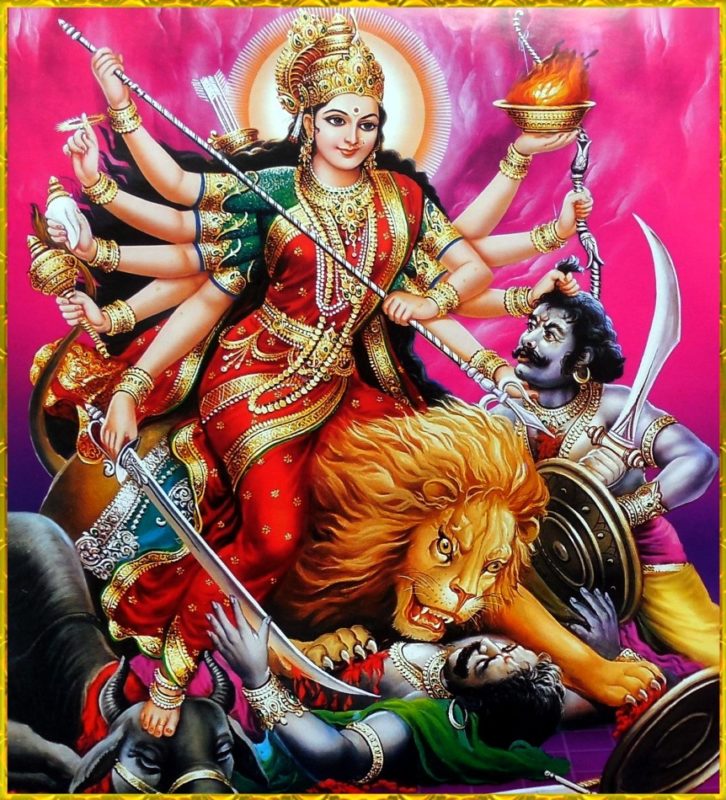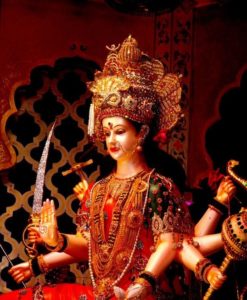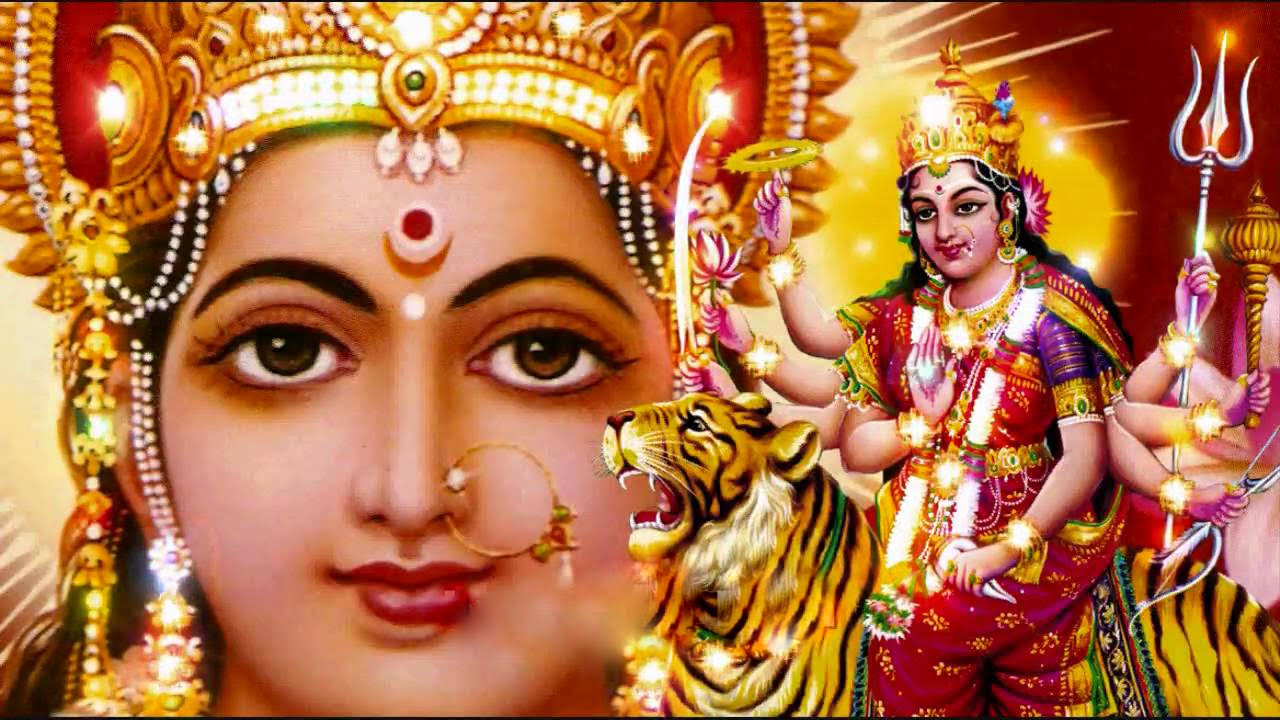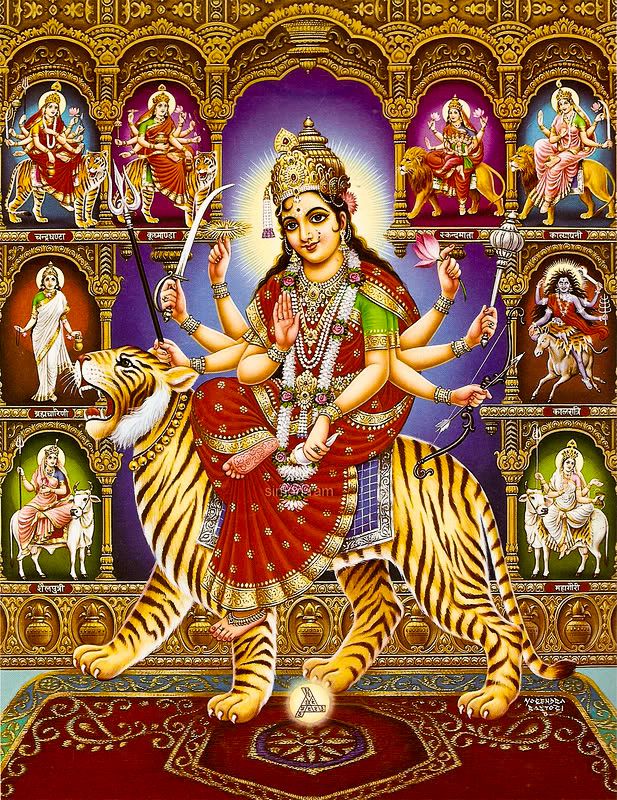No products in the cart.
Devi Navaratri in Ashvyayuja Month
One of the famed Festivals afore titled occupying a social and spiritual attachment in entire Bharat, especially in the Eastern and Southern belts covering West Bengal and North East, Odisha, Tamilnadu, Karnataka and Andhra Pradesh. In Uttar Bharat, Ram Leelas climaxed with Ravana’s effigy burnings and in Paschima Bharat, the Gadbha and Dandiya Raas are significant. Besides Pujas in Temples, temporary and brightly lit and street corners and socially vantage points in all villages, townships and cities, as the annual social gatherings come alive in full glory. ‘Kolus’ are a compelling annual festivities looked forward to by men and women, boys and girls and children especially in Andhra / Telangana, Tamilnadu and Karnataka, while this social joy is rampant in these States as reserved for Makara Sankranti.
The Nava Ratraas are the duration of worship to Adi Para Shakti and Sapta Matrikas Brahmi of Brahma Shakti who is the Shabda Swarupa and the Repository of Knowledge being of Satva Guna and of Shrishti Kaaraka; Vaishnavi is originated from Tejas and Rajas the Sthiti kaaraka; Maheshwari , the Tamo Shaki or of the Antaryami or the latent Energy emanating from Maha Maya; Kaumari the Sadhana Jnaana Shakti originated from Jnaana and Dharma being the root of ‘Shaasta’; Vaarahi the Yagjna Shakti being the embodiment of physical strength and well being originating for ‘Anna’ or Food Energy; Aindri the Shakti of Courage, Protection and Prowess like from Indra’s Vajraayudha; and Chamundi the Pouranik Annihilator of the Demon Rakta Beeja or the True Balancer of the Vitrue and Vice who manifets herself at the joints of Creation and Destruction which is signified as a state of Samadhi!
Nava Durgas
As worshipped during the Navaratri are Shaila Putri of Himalayas with Crescent Moon providing Mental Peace and Equanimity; Brahmacharini holding rosary and kamandalu being the Devi of Srishti-Sthiti-Vigjnaana-Moksha daayani or of Creation-Existence-Knowledge- and Absolute Bliss; she is the Yogini and Tapaswini as of Virgin form- Chandraghanta Durga riding a Vyaghra or Tiger as the embodiment of wrath and violene adorned with half moon and a ghanta or bell-Kushmanda Durga carrying loads of blood spilling out of a pumpkin with hands of blood as also being responsible for sustaing the Solar System headed by the radiant Surya Deva- Skanda Maata urga seated on a bejewelled throne of Gold ever propitious nature to the virtuous and the quick destroyer of evil as the symbol of courage and ‘Dharma Shaasana’ being ‘Dharma Shaasta’- Katyaayani holding a ‘Chandrahaasa’ or a long and unsheathed sword of valor and intrepidity ever ready to destroy the evil and riding high on a sky bound lion-Kaala Raatri the most ferocious Devi with protruded and elongated lips riding an ass and destroying pitch darkness and severe Agjnaana or pure lack of Understanding and mental maturity with ever sharp and dazzling sword of golden sheath; Devi Maha Gauri riding a vrishabha or a bull with resplendent clothes bestowing all-round auspiciousness; and Siddhi daatri who is ever victorious paving ways and means success and fulfillment.
At a designated Place in the center of a Hall, a raised platform made of bricks, called ‘Vedi’ of six feet wide and one and half feet height be arranged. On the Pratipad Tithi of Asvayuja, the Person(s) concerned sponsoring the Navarartras must arrive clean and composed, having already performed their ‘Sandhyavandanam’ or daily pujas and should seek the blessings of Brahmanas appointed ( either nine, or five or three or atleast one) after presenting them new clothes and Dakshina. ‘Swasti’ Mantras followed by Veda Parayana would be recited. An Idol of nicely decorated Durga Devi seated on a Lion, with either four or eighteen hands, with symbolic arms and jewellery be installed as also a Pot of Sacred River Water placed over an
‘Yantra’ (diagram) representing Grandhis (Chambers) of Trinity and relevant Demi-Gods and Planetary Heads, while rendering the relevant Mantras. With various Worship Materials in place, the Puja would commence along with the Mantram ‘Om Hrim Srim Chandikaya namah’; ‘Arthies’ (Camphor cum oil soaked cotton vick lamps shown to Deity ) are performed, accompanied by instrumental music, singing and dance in praise of Maha Devi Bhagavati. ‘Bala Kanya Bhog’ or Prasad (Food material offered to Deity) to Virgins of the ages of two to ten years of age are worthy of worship. Such Kanyaas are designated as Kumari, Trimurti, Kalyani, Rohini, Kaali,Chandika, Shambhavi,Durga and Bhadra. ‘Aavahana’ or Invocation of such Kumaris in their Puja would be as follows: Mantraakshara mayeem Lakshmim Maatrunaam Rupa dhaarineem, Nava Durgaatmikaam Saakshaat kanyaanmavaa hyamyaham/ Jagatpujye Jagadwandye Sarva Shakti Swarupini, Pujaam grihaana Koumaari Jaganmaatarnamostutey/ After the Avaahana Mantra the Kanyaa Puja is commenced with Paada prakshaalana or washing the feet of the Kumari and offering Vastra-Kumkuma-Gandha-Dhupa-Deepa-Bhojanas. During the Puja, rcitation of Chandi-Paatha is required while others prescribe Lalita Sahasranaamaa too.
Upaanga Lalita Vrata: This Vrata is scheduled on Ashwiyuja Shukla Panchami and ‘Aparaahna’ is suitable; if Aparaahna is not available on Panchami, then the previous Aparaahna would be suitable. Some opine that Lalitha Puja is better performed in the night.
Saraswati Puja
This popular and Sacred Puja of Devi Saraswati is performed on Ashviyuja Shukla Paksha Saptami but significantly in the Moola Nakshatra. Sthaapana has to be in Moola, Avaahana and Puja are to be in Purvaashaadha Nakshatra, Bali daana in Uttaraashaadha and Udwaasana in Shravana:
Mooleshu Sthaapanam Devyaah Purvaashaadhaasu pujanam,Uttaraasu Balim tadyacchravaney na visarjayet/
But Rudraamala Grandha states: Avahana and Anga Puja be done in Moola Nakshatra, detailed Puja in Purvaashadha without Avahana, Bali daana in Uttaraashaadha, and Anga Puja before Visarjana in Shravana Nakshatra . In any case, Avahana of Saraswati is to be done three muhurtaas before ‘Suryastama’ but if Moola Nakshatra is unvailable at that time then Aavahaya is done next day’s Moola’s dwiteeya paada. The Puja in brief is initiated as follows:
Pustakeshu yato Devi kreedate paramaarthatah, tatastatra prakurveeta dhyaanamaavaahanaadikam/ Dhyanamevam prakurveeta saadhako vijitendriyah Pranavaasanamaarudhyam tadardhatvena nishchitaam/ Ankusham chaaksha sutram cha paasham veenaamcha dhaarineem,Muktaahaara samaayuktaam moda rupaam manoharaam/ Kritena darpanaa bhyena vastrenopari bhushitaam, sustaneem veda vedyaamcha chandraarthakrita shekharaam/ Jataa kalaapa yuktaam purna chanddranibhaananaam, Trilochanaam Maha Deveem swarna nupura dhaarineem/ Katakaih swarnaratnaadyairmuktaavalaya bhushitaam, Kambukanthim sutaamroshtheem sarvaabharana bhushitaam/ Keyurairmekhalaadyascha dyotayanteem jagatrayam, Shabda rahmaatmikaam Deveem dhyaana karma samaahitah/ Sarasvateemaavaahayaami-aasanam samarpayaami-paadyam-arghyam-aachananeeyam-madhuparkam-pancaamritasnaanam-vastrayugmam-brahma sutra/ yagjnopaveeta-aabharana-gandha-akshata-puhspaan- deepa-dhopanaivedya-taamboola-neeraajana-mantrapushpa- pradakshina- namaskaaraan samarpayaami/ Praardhanaas: Paahi paahi Jagadvande namaste bhakti vatsale, Namastubhyam namastubhyam namastubhyam namo namah// Paashankusha dharaa Vaani Veenaa pustaka dhaarini, Mama vaktre vasennityam dugdhakundendu nirmalaa/ Chaturdashasu vidyaasu ramate yaa Saraswati, Chaturdashasu lokeshu saa me vaachi vaseccharim/ The Saraswati Vrata concludes with Kathaa shravana-pathana.
Special worship is arranged on the ‘Saptami’,‘Durga Ashtami’, and ‘ Maha Navami’ days ie. the seventh, eighth and the ninth days of the Festival. Devotees not quite involved in the previous days too would like to invariably perform Worship as per their choices in their own Puja Places in their own residences, or Temples or Specially built up (improvised) Group ‘Mandaps’ for community worship.
Saptami is described as the day when Maha Bhagavati takes a ‘Saakar’or Bodily Incarnation to destroy the Demon ‘Mahisha Asura’ who had the form of a Buffalo, creating havoc to the World. The following day, popular as ‘Durga Ashtami’, Maha Bhagavati in the Incarnation as Durga Devi looks fierce and angry with the Demon and prepares for a violent battle with him and fellow Demons and massacres them all. It is also believed that Bhadra Kali was incarnated in a furious and gruesome form to devastate the ‘Yajna’ that was performed by Daksha Prajapati, the father of ‘Maha Sati’, the better half of Lord Siva and the Kali Incarnation was surrounded by innumerable ‘Yoginis’ or the multiple permutations of Sixty Attendants of Bhadra Kali who created mayhem at the Yajna and killed Daksha and his followers.On Maha Navami Day, Maha Bhagavati in the forms of fury and destruction punished the evil forces and brought back Her own Creation to normalcy and established balance of power.
Thus the two days of Durga Ashtami and Maha Navami are the days of the Grand Finale of the Navarathras, which are remembered for the relief, climactic joy and devotion experienced by the humans and Gods alike. The day next day falling on Vijaya Dasami is the day of high celebration and gratitude to Maha Bhagavati for Her ‘Leelas’or Playful Actions that remain complex forever in human minds, soaked deep in the grip of Maya or Illusion! Whoever observes Navarathri Pujas with devotion are certain to reap benefits- Dharma ( Virtue), Artha (Prosperity), Kaama ( Worldy fulfillments) and Moksha ( Eternal Bliss) with the blessings of Maha Bhagavati. Even those who committed unpardonable misdeeds earlier- ‘Pancha Patakas’or heinous acts viz. killing Sages and Brahmanas, stealing gold or valuables, drinking and gambling, adultery or association with perpetrators of sins-would be spared if only the Navaratra Worship is performed with faith.
Navaratri Vidhis
Atra Nava Raatrey Ghatasthaapanam Pratarmadhyaahney Pradosha kaaley cheti Trikaalam Dwikaalam-Eeka kaalam vaa Swaswa Kula Devataa pujanam Saptashatyaadi japokhanda deepah Achaarapraapta maalaa bandhanam Upavaasa Nakthaikabhaktaadi niyamah Suvaasini bhojanm Kumaari bhojana pujaaadi antey Saptashatyaadi Stotra Mantra Homaadi ityetaani vihitaani
 During these Navaraatraas the Duties required to be performed include Kalasha Sthaapana followed by daily Trikaala Puja as per ‘Vamshaachaara’, Saptapadi and other Japaas, Akhanda Deepa, Maalaa bandhana as per Kulaachaara, Upavaasa, Nakta-Eka bhuktaadi niyama, Suvaasini –Kanyaa pujaas and Bhojana and Homa Karyaas). Kalasha Sthaapana should not be performed in the nights. The Kalasha should be arranged on a Clean Vedika / Platform made of Pancha Pallavaas, milk, fruits, ‘taambula’/betel nuts and leaves, Kunkuma, Dhupa , Deepa and such other requirements of Puja. On Pratipaada morning after ‘Abhyangana’ or head bath, be seated by Grihastis along with wife and make the Sankalpa as follows:
During these Navaraatraas the Duties required to be performed include Kalasha Sthaapana followed by daily Trikaala Puja as per ‘Vamshaachaara’, Saptapadi and other Japaas, Akhanda Deepa, Maalaa bandhana as per Kulaachaara, Upavaasa, Nakta-Eka bhuktaadi niyama, Suvaasini –Kanyaa pujaas and Bhojana and Homa Karyaas). Kalasha Sthaapana should not be performed in the nights. The Kalasha should be arranged on a Clean Vedika / Platform made of Pancha Pallavaas, milk, fruits, ‘taambula’/betel nuts and leaves, Kunkuma, Dhupa , Deepa and such other requirements of Puja. On Pratipaada morning after ‘Abhyangana’ or head bath, be seated by Grihastis along with wife and make the Sankalpa as follows:
Mama saha kutumba syaamuka Devataa preeti dwaaraa Sarvaapadcchaanti purvaka Deerghaayurdhana putraadi vriddhi Shatru Jaya keertilaabha pramukha Charurvidha Purushaartha siddhyartha Madhya Prabhriti Mahaa Navamiparyanta trikaala mekakaalamvaamuka Devataapujaamupavaasaa Naktaikabhaktaanyata niyama sahitamakhanda deepajwaalana Kumaaripujana Chandi Saptashati paatha Suvaasini bhojanaadi rupam Sharada nava raatrotsavaakhyam karma karishye!
After the Sankalpa as above Kalasha Sthaapana follows;
Tadadou Nirvighnataa siddhyartham Ganapati Pujamam Punyaahvachanam Chandi Saptashati Japaadyartham Brahman varanam karishye/
As the Kalasha Sthapana is being performed, Bhumi is prayed to and touched with the Mantra Mahaadyou; to perform ‘Ankuraaropana’ collect some ‘Mrtittika’ for the Ankuraarpana and recite the Mantras:
Aoushaddhayassa- Akaleshu- Imammey Gangey- Gandha dwaaraa- Kandaatkaanda- Ashwattevah-Syonaa Prithivi-Yaah phalineeh-Sahiratnaani Hiranya Rupam-Uvaasu vaasaa-Purnaadarvi-Tatwaayaami/
by inferring various acts of collecting Aoushadhis from Mrittika to fill up the Kalasha with the Sacred Water along with Pancha Pallavaas, Ratna-Hiranyaas, and perform Puja to Varuna Deva, Kula Devata and Devi in various Forms as follows:
Jayanti Mangalaa Kashi Bhadra Kaali Kapaalini, Durgaa Kshamaa Shivaa Dhaatri Swaahaa Swadhaa Namostutey/ Aagaccha Varadey Devi Daithua darpa nishudini, Pujaam grahaana Sumikhi namastey Shankara priye!
There after along with other Stotraas like Shri Sukta, Purusha Sukta and Prathama Ruks and formally worship with ‘Shodasopachaaraas’ like Aasana-Padya-Vastra-Dhupa-Deepa-Naivedyas and Sarva Mangala Maangaley and other ‘Praarthanaas’. Offer of ‘Bali daana’, Kushmaanda daana, ‘Kushmaanda Khandana’and Shanti mantraas ending up with Om Shaantisshaanthisshaantih/ Finally ar the end of the daily Nava Raatri Puja there shoud be resolve :
Akhanda deepakam Devyaah preetaye Nmava traatrakam, Ujjwalaye dahoraatra mekachitto Dhrudha Vrata – I resove with unswerving devotion that the Akhanda Deepa shall be firmly set aflame all through the Nava Raatris and the daily formal worship as presribed!
Navaavarana Puja
After ensuring external and internal purity ( ‘Bahya Suddhi’ and ‘Antar Suddhi’) and squatted with concentration, one should initiate ‘Achamana’ ( sipping water thrice) with ‘Kesavaya Svaha, Narayanaya Svaha, Madhavaya Svaha etc; be ready with articles of worship; perform ‘Pranayama’ or controlled breathing; follow by ‘Bhuta Suddhi’ or purification of the old and installing the new representaion of Devi Bhagavati and observe internal ‘dhyana’ (meditating) to mean: dissolve Earth into Water, Water into Fire, Fire into Air, Air into Ether, Ether into ‘Ahamkara’, ‘Ahamkara’ into ‘Mahat’(Great Energy) and ‘Mahat’ into ‘Prakriti’ or ‘Maya’, or in other words imagine transformation of the Five Elements into Moola Prakriti; follow Bhuta Suddhi by ‘Jeeva Suddhi’ or align the Self with Parama Devi; proceed further by mentally setting Six Chakras (outer- most circle inserted by an inner circle, further inserted by four more inner circles one within another) thus arranging the installation of ‘Shat chakropasthitha Samsthitha’ simultaneously pronouncing the afore mentioned nine lettered Mantra, viz. ‘Om Aim Hrim Kleem Chamundaya Vicche’ and align the Mantra to the six chakras as also touching the relevant body parts of the Worshipper concerned. The ‘Kartha’or the Worshipper should perform ‘Sankalpa’ or mentioning the ‘Tidhi’(date), ‘Vara’ ( day) ‘Nakshatra’ or the relevant ‘Star’of the day, ‘Aayana’or the Course of the Solar Movement, Month, Year, Manvantara, Yuga, Place, Name of the Performer, ‘Gotra’ etc.; sprinkle water on the self, surroundings, articles and place of worship and recite the Mantra to remove obstacles for worship viz. ‘Astraya Phat’; place the Sacred Copper Plate in position; [ readily available from contemporary markets or draw two hexagonal triangles – one straight and another inverted- crossing each other, draw a figure outside that image, an octagonal form of eight petals and outside this a ‘Bhupura’ or boundary lines. On the eight petals are inscribed the Bija Mantras with the ninth word inscribed at the central Ovum].The ‘Bindu’ or ‘Adhara Shakti’ or the Super Energy at the Central Ovum which one has to worship. The ‘Yantra’( diagram) is expected to resemble human body and is a mystical representation of Devi Maha Bhagavati to be worshipped.
Actual Puja commences while seated facing east and looking at the tip of the top triangle of the Yantra. The lowest triangle at the bottom right represents Lord Ganesha whose prayer is a traditional must. The bottom left hand side is governed by Sun God, top left Corner by Lord Vishnu, and top right corner by Lord Shiva. The ‘Lokapalas’ or Direction-wise Guards protect as follows: Indra guards East, Agni ( Fire) guards South East, Lord Yama guards South, Nirruti South West, Varuna the God of Rain and Water guards the West, ‘Vayu’ the God of Air guards North West, Soma or Moon guards North, and Ishana protects North East. After propitiating the Devas and Lokapalakas, Puja to Devi Bhagavati starts by Kara Nyasa and Anga Nyasa. The Karanyasa Mantras are: Aim- angushttabhyam Namah, Hreem- Tarjaneebhyam Namah, Sreem – Madhyamabham Namah, Aim- Anamikabhyam Namah, Kleem Kanishthikam Namah, Souh Karatala prushthabhyam Namah. Anganyasa Mantras are: Aim Hridayaya Namah, Hreem Sirase Svaha, Sreem Sikhayavoushat, Aim Kavachahum, Kleem Netratraya aushath, Sauh Astrayaphut. Salutations to Maha Devi as follows:
Om Aim Sreem Aim Kleem Souh-Kriya Shakti Peethayai-Shri Padukayam Pujaami
Om Aim Sreem Aim Kleem Souh-Jnana Shakti Kundalinyai- -DO-
Om Aim Sreem Aim Kleem Souh- Iccha Shakti Maha Tripura Sundaryai- -DO-
Nithyamba Pujas: The following Mantras to added after each Nityamba:-
Om Aim Hreem Shreem Aim Kleem Souh XXXX Sri Padukayam Pujaya Namah
Example: Do Kameswari Nityamba Do
Bhagamalini Nityamba, Nityaklinna Nityamba, Bherunda Nityamba,Vahnivasini Nityamba, Maha Vajreswari Nityamba, Sivaduti Nityamba, Tvarita Nityama, Kula Sundari Nityamba, Nitya Nityamba, Neelapataka Nithyamba, Vijaya Nithyamba, Sarva Mangala Nithyamba, Jwalamalini Nitymaba,Chitra Nityamba, Maha Nitya Nityamba, Parameswara Nityamba, Parameswari Devi, Mitresamayi Devi, Shashtheesa Mayi Devi, Uddishamayi Devi, Charyanathamayi Devi, Lopamudramayi Devi, Agashyamayi Devi, Kala- tapanamayi Devi, Dharmacharyamayi Devi, Muthakesivaramayi Devi, Deepakalanathamayi Devi, Vishnudevamayi Devi, Prabhakara Devamayi Devi, Vasudevayamayi Devi, Ratnadevimayi Devi and Sri Ramanandamayi Devi.
Navavarana Puja- Names of Devis in Nine Enclosures
 Prathama Avarana: (First Enclosure) in Three Outer Lines:
Prathama Avarana: (First Enclosure) in Three Outer Lines:
First Line: Anima Sidhamba, Laghima Sidhamba, Mahima Sidhamba, Isitva Sidhamba, Vasitva Sidhamba, Prakamya Sidhamba, Bhuti Sidhamba, Iccha Sidhamba, Prapti Sidhamba and Sarva Kama Sidhamba.
Second Line: Sri Brahmi Matruka, Maheswari Matruka, Kaumari Matruka, Vaishnavi Matruka, Varahi Matruka, Mahendri Matruka, Chamunda Matruka, and Mahalakshmi Matruka.
Third Line: Sarva Sankshobhini Devi, Sarva Vidravini Devi, Sarvakarshini Devi, Sarva vashankari Devi, Sarvonmadini Devi, Sarva Mahankusa Devi, Sarva Khechari Devi, Sarva Beeja Devi, Sarva Yoni Devi, Sarva Trikhanda Devi, Trilokya Mohana Chakraswamini Devi and Prakata Yogini Devi.
Dwiteeya Aavarana (Second Enclosure):
Kamakarshini Shakti, Buddhyakarshini Shakti, Ahankarakarshini Shakti, Sabdakarshini Shakti, Sparshakarshini Shakti, Rupakarshini Shakti, Rasakarshini Shakti, Gandhakarshini Shakti, Chittakarshini Shakti, Dhairyakarshini Shakti, Smrutyakarshini Shakti, Namakarshini Shakti, Beejakarshini Shakti, Atmakarshini Shakti, Amrutakarshini Shakti, Sharirakarshini Shakti, Sarva Aasha Paripurka Chakraswamini and Gupta Yogini.
Triteeya Avarana ( Third Enclosure):
Anga Kusuma Shakti, Ananga Mekhala Shakti, Ananga Madana Shakti, Ananga Madanatura Shakti, Ananga Rekha Shakti, Ananga Vegini Shakti, Ananga Ankusha Shakti, Ananga Malini Shakti, Sarva Sankshobhana Chakraswamini, and Gupta thara Yogini.
Chaturdha Avarana ( Fourth Enclosure):
Sarvakshobini Devi, Sarva Vidravini Devi, Sarvakarshini Devi, Sarvahladini Devi, Sarva Sammohini Devi, Sarva-Sthambhini Devi, Sarvajhrumbhini Devi, Sarvavashankari Devi, Sarva Ranjani Devi, Sarvonmadini Devi, Sarvatha Sadhika Devi, Sarva Sampatti Purani Devi, Sarva Mantramayi Devi, Sarva Dvandva Kshayankari Devi, Sarva Soubhagya Dayaka Chakraswamini Devi and Sampradaya Yogini Devi.Panchama Avarana (Fifth Enclosure): Sarva Siddhiprada Devi, Sarva Sampathprada Devi, Sarva Priyankari Devi, Sarva Mangala Karini Devi, Sarva Kamaprada Devi, Sarva Dhuhkha Vimochani Devi, Sarva Mrithyu Prasamani Devi, Sarva Vighna Nivarini Devi, Sarvanga Sundari Devi, Sarva Sowbhagya Dayani Devi, Sarva Ardha Sadhaka Chakraswamini and Kulotheerna Yogini.
Shashtha Avarana ( Sixth Enclosure):
Sarvagya Devi, Sarva Shakti Devi, Sarva Aishvarya Pradayani Devi, Sarva Jnanamayi Devi, Sarva Vyadhi Vinasini Devi, Sarvadhara Swarupa Devi, Sarva Papahari Devi, Sarva Anandamayi Devi, Sarva Raksha Swarupini Devi, Sara Epsitha Phalaprada Devi, Sarva Rakshakara Chakra Swamini and Nigarbha Yogini.
Saptama Avarana ( Seventh Enclosure):
Vasini Vagdevi, Kameswari Vagdevi, Modhini Vagdevi, Vimala Vagdevi, Aruna Vagdevi, Jayani Vagdevi, Sarva Eswari Vagdevi, Kaulini Vagdevi, Sarva Rogahara Chakraswaini, Rahasya yogini, Banini, Chapini, Paasini and Ankusini.
Ashtama Avarana (Eighth Enclosure):
Maha Kameswari Devi, Maha Vajreswari Devi, Maha Bhagamalini Devi, Sarva Siddhiprada Chakraswamini and AtiRahasya Yogini.
Navama Avarana ( Ninth Enclosure):
Sri Sri Bhattarika, Sarvanandamaya Chakraswamini and Parapara Rahasya Yogini.
Conclusion of Navavarana Puja:
Tripura Devi Namah: Dhyayami; Tripuresi Devi Namah: Avahayami; Tripura Sundari Devi Namah :Asanam Samarpayami;Tripurasiddhi Devi Namah: Snanam Samarpayami; Tripuramba Devi Namah: Vastram Samarpayami; Maha Tripura Sundari Devi Namah: Abharamam Samarpayami; Maha Maheswari Devi Namah: Gandham Dharayami; Maha Maharagni Devi Namah: Pushpam Pujayami; Srimad Simhasana Iiswaryai Devi Namah:Padam Pujaami; Lalitha Devi Namah: Gulphou Pujayami; Maha Raagni Namah: Janghou Pujayami; Paramakushi Namah: Januni Pujayami; Chapinyai Namah :Urum Pujayami;Tripurayi Namah:Katim Pujayami; Maha Sundaryai Namah: Nabhim Pujayami; Sundaryai Namah: Vasitrayam Pujayami; Chakranathaya Namah:Udaram Pujayami; Charinyai Namah: Kantham Pujayami; Chakreswaryai Namah:Oshtham Pujayami; Maha Devai Namah: Kapolam Pujayami; Kameswaryai Namah: Dantapanktim Pujayami; Parama Eswaryai Namah:Chbukam Pujayami; Kamaraja Priyayai Namah:Nasika Dwayam Pujaami; Kamakotikayai Namah: Bhru Madhyam Pujaami; Sarv Patalayai Namah: Mukham Pujayami; Kulanthayai Namh: Parswam Pujaami; Amnayanathyayai Namah: Siram Pujamami; Sarva Amnaya Nivasinyai Namah : Padukam Pujayami; Maha Sringara Nayikayai Namah : Sarvangyani Pujayami. Maha Shakti Devi Namah:Dhoopam Aghrapaami; Maha Guptha Devi Namah: Deepam Darshayami; Maha Gupta Devi Namah: Nivedaym Samarpayami; Maha Ananda Devi Namah:Tamboolam Saparpayami; Maha Skanda Devi Namah: Mantra Pushpam Samarpayami; Maha Maha Sri Chakra Nagara Samragni Namah: Pradakshina Namaskaran Samarpayami. [Note: If the detailed worship on the above lines is not possible to perform, at least the following powerful Panchadasakshari mantra may be recited 108 times each day keeping in view the Sri Yantra with concentration: Ka E La Hreem-Ha Sa Ka Ha La Hreem-Sa Ka La Hreem
[Compiled and Edited by VDN Rao]







